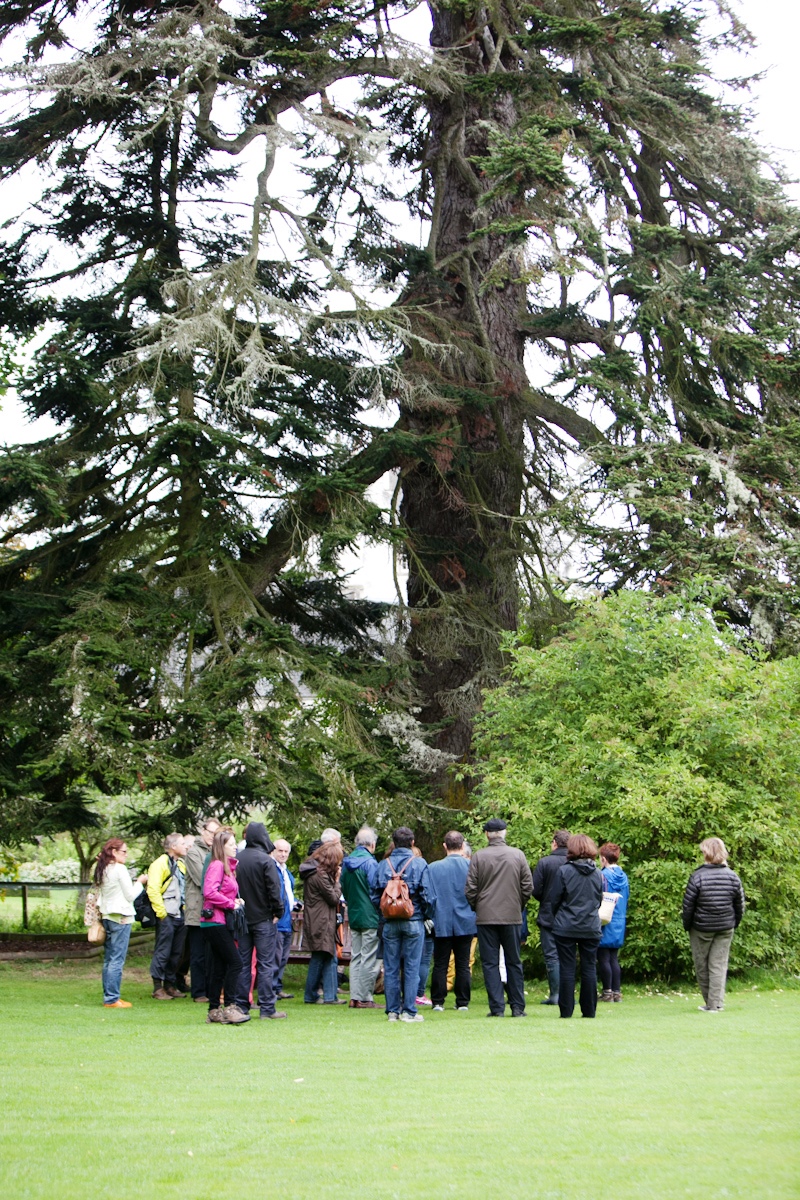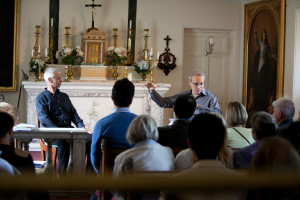
The 4th Kirjat, Reunat ja Bikes Festival pidettiin Skotlannin pisimpään yhtäjaksoisesti asuttu asunnon, Traquair talo joen Tweed Scottish Borders. Järjestäjä Beyond Borders Scotland on ainutlaatuinen festivaali kirjallisuuden ja ajattelun, joka kokoaa yhteen johtavia kirjailijoita, poliitikot, sotilaat, lawyers and artists to discuss topics relevant to international relations Scotland’s role in the world. Two talks “Understanding the Islamic World” and “Iraq Ten Years On: Mitä Lessons Syyrian ja U.N.?"Kantavat osoitus leveys keskustelua. SNSI coordinator, Robert Wild osallistui kaksi tapahtumaa; kävelymatkan otsikolla "Jos puut voisivat puhua – mitä he sanovat?", ja puhua "Neurotieteen antiikin ja Sacred luontokohteiden".

Ryhmä kuntopolku Ian Edwards, johtaja tapahtumia Royal Botanic Garden Edinburgh, keskustella kulttuuriyhdistys puita samalla Catherine Maxwell, jonka perhe on ollut asuinpaikka 300 vuotta edellyttäen historiaa puiden. (Kuvat kohteliaisuus Beyond Borders)
Sunnuntaiaamuna kävelymatkan oli "Talking Science Project"Yhteistyössä Royal Botanic Garden Edinburgh. Se tutkitaan Traquair historiallisen maiseman ja löysi tarinoita sen uskomattomia puita (www.traquair.co.uk). Ian Edwards, johtaja tapahtumia Royal Botanic Garden Edinburgh, johti puhua luonnonmaantieteellisissä historia ja kulttuuriyhdistys puiden kuolinpesän lukien Yew, Kalkki, Silver Fir and Hazel. Catherine Maxwell Stuart, omistaja ja jonka perhe on ollut asuinpaikka 300 vuotta edellyttäen historiaa puiden.
Ryhmä valmis keskustelun mietiskelevä paikka luonut Ancient Yews että voi on säilynyt aika on nyt selvitetty Ettrick Forest, jossa Traquair House - metsästysmaja Skotlannin kuninkaat, sillä noin 1107 – was originally been situated. Robert posed that if trees could talk they may have a few questions of us like: Mitä teit Ettrick Forest? Mitä ihmettä olet tehnyt puolet metsistä planeetalla? Luuletteko te huolta meistä puita? Really we look after you!
Following the walk the talk took place inside the packed Chapel. Entitled “Neurotieteen Muinaisen ja Sacred luontokohteiden: WHY antiikin paikkoja herättää niin voimakas otteen kulttuuriamme ja olisi suojeltava aikoina konfliktin ", the talk explored Sacred Natural Sites and made links to the emerging understanding of Neuroscience.
Robert kicked off saying that Sacred Natural Sites can be described as places where the human mind meets Nature. He observed that the Traquair chapel (, joka on suhteellisen uusi mukautettu tätä tarkoitusta varten 1829) oli muutamia merkkejä luonnossa, mutta se on erittäin todennäköistä, että kaikki pyhät tilat perin luonnosta peräisin.
Robert lähti kuvaamaan pyhiä luontokohteiden oli ja miksi he ovat saaneet kiinnostusta kansainvälisten suojelu-liikkeen. Nature conservation practitioners have a very pragmatic interest in sacred natural sites as they protect a wide range of rare species. This is particularly important as we have now entered the 7th suuri sukupuuttoon tapahtuma, with hundreds of species becoming extinct daily. Beyond this, kuitenkin, pyhä luontokohteiden myös upottaa syvälle joukko arkkityypit ihmissuhteiden että voisimme oppia asettamaan kestävämmän tien ihmiskunnan.
Yksi tällainen käsite on "Sanctuary" that seems to be a direct import from ancient European sacred groves into the early Christian church. Sanctuary arose in the sacred groves of Europe where, no hunting was allowed and if a hunted animal found refuge in a sacred grove the hunt had to stop. Human fugitives could also find sanctuary in the sacred grove. Many of these provisions still hold in the sacred groves of Africa and Asia. At some point this sanctuary principle transferred into the church.

Ennen päästä neurotieteen pyhän, Robert Wild (jäljellä) explored sacred sites as potential areas for limiting conflict. (Kuvat kohteliaisuus Beyond Borders)
Vihdoin, ja ennen päästä neurotieteen pyhän, Rob focused on sacred sites as potential areas for limiting conflict. Rob presented an example recently shared by colleagues at the Aigine Cultural Research Centre suhteen 2010 Kirgisian konfliktiin, jossa satoja ihmisiä kuoli ja tuhansia kotiseudultaan vuonna ristiriita Kirgisian ja uzbekit vuonna maan eteläosassa. Monet joutuneiden asukkaiden sai turvapaikan pyhä paikka olla turvasatama ajoissa konfliktin:
"Kamchieva Mopasha Etniset Uzbekistanin romaaneja ja"shaiyks"Tai holhooja sivuston valtioiden: “Kun on katastrofi, ihmiset tulevat tähän pyhäkkö ja löytää turvapaikan ". According to her, klo korkeus konfliktin kesäkuussa 2010, [monet ihmiset] sinne sekä Kirgisian ja uzbekkeja, mutta he eivät pyydä kuka on kuka, [mutta] yhdessä uhrasi Jumalalle, anoen rauhan palauttaminen ja harmoniaa. Monet pyhiinvaeltajat oli jäänyt niille kaksi tai kolme päivää [konfliktin] reunalla Mazar (Pelops). As [Eräs haastateltava] Akbarov Salbar said, "Ei yksi nenä tai yksi suu loukkaantui". Toinen haastateltava sanoi, että pyhät paikat ovat alueita väkivallattomuuden, and moreover places where steps are taken to overcome violence”.
At this point Robert then handed over to Tim Phillips. Tim is an international peace maker and co-founder of the Harvardin yliopiston Project Justice in Times of Transition ja on ollut mukana monissa rauhanneuvotteluihin ottamatta Pohjois-Irlantia, Sri Lanka ja Lähi-idässä.
Tim introduced the emerging discipline of neuroscience and discussed recent lessons that are being learnt in relation to conflict resolution. This includes that different types of thought pattern are processed in different parts of the brain. Different parts of the brain process different emotions and thoughts that are analogous the stages of evolution. Rational thought is now understood to be processed in a different part of the brain that deeply held and sacred values. These new understandings have profound implications for the way that we negotiate over issues. This is the case when seemingly rational solutions to deeply held or sacred values will not be easily considered by negotiating teams.
Sacred natural sites have been contested lands at the same time locations of peace and cooperation. They also embed critical models of human relationships with nature. At a time when our relationships with nature need significant healing; hengellinen, tieteellistä ja yhteiskunnallista ymmärrystä ihmisten käyttäytymistä ja toimintaa ovat välttämättömiä.






